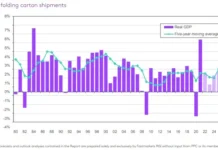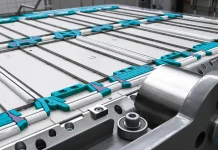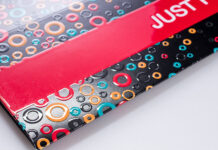by Brittany Willes, editor, PostPress

The devil is in the details, as the saying goes. While this has always been true of the printing industry, it’s become even more important with the advent of digital technology. When it comes to printing on digital stock, strict attention to the smallest details is what transforms a good print job into an amazing one. Working with digital stock presents its own unique challenges – ones that experienced operators didn’t necessarily have to worry about in the old world of offset printing.
For instance, when it comes to creasing and folding digital stock, printers are bumping up against increasing instances of cracking and/or flaking along the fold. “Although it was not a problem in the past, a surefire way to guarantee a dissatisfied customer today is to present them with a completed folded project that has cracking along the paper folds,” read a blog post from Whitaker Brothers, a company of self-described office supply nerds based in Rockville, Maryland, specializing in cutters, folders and shredders. The blog post, Should You Be Scoring or Creasing, went on to state, “The good news is that while your competitors may tell their customers it is a necessary evil, there are solutions available to prevent this damaged final appearance.”
So, how can printers avoid cracking – and dissatisfied customers – when it comes to creasing on digital stock? As they say, the devil is in the details.
Creasing vs. scoring
With digitally-printed stock, it’s important to know which method of creating a fold is best: creasing or scoring. The two terms often are used interchangeably, yet experienced binders and printers know they are actually very different processes that produce very different results.
“Scoring machines fold paper by reducing its stiffness with the use of a rotary wheel,” explained Whitaker Brothers. “It stretches the paper and then utilizes severe pressure to create the fold in the paper.” This combination of pressure and stretching results in the top layer of paper fibers essentially being cut through. Most notably, scoring creates only a single stress point to achieve the fold.
By contrast, creasing relies on creating two parallel folding points on either side of the fold. According to Whitaker Brothers, “Since the folding points now have doubled, the paper still folds 180 degrees, but the stress disperses to two different points on the paper.”
Noting the differences between scoring and creasing is especially important when it comes to digitally-printed stock. Because the digital print process consists of pressing a layer of toner only upon the paper’s surface, scoring – which tears through the top layer of paper fibers – can ruin the printed piece. Furthermore, because scoring produces heat that fuses the toner to the paper, “this causes the paper to dry out, causing intensified cracking along the fold,” stated Whitaker Brothers.
Thus, when it comes to digital stock, creasing over scoring is the recommended process. However, creasing is not without its challenges.
Creasing on digital stock

While excess heat is a pitfall when it comes to scoring digital stocks, it also has proven to be a challenge when it comes to creasing. Digital stock itself is heat treated and therefore is, “much more prone to the defect of cracking than traditional offset materials,” explained Graham Harris, managing director for Tech-ni-Fold, which specializes in creasing and print finishing. Headquartered in the United Kingdom, Tech-ni-Fold has spent more than 15 years addressing common finishing problems – such as the increased rate of cracking along folds that has occurred due to the rise of digital printing.
Kevin Chen, product manager for Duplo USA, Santa Ana, California, confirmed Harris’ assessment of the difficulty of creasing digital stock. According to Chen, “Creasing on digital stock is extremely difficult because of the different variations of toners and inks being used in the digital age right now. Each toner/ink reacts differently to certain creasing mechanisms.” Back in the days of traditional offset printing, the printing process was universal all around. Those days have mostly passed.
“It’s a vicious cycle that often repeats,” explained Harris. “Creasing machine manufacturers develop their latest super solution to solve a production headache, only to have the rules change all together.” As a result, creasing has become a critical application.
While the technology for creasing paper stocks has come a long way over the last several years, digital stock continues to present problems. For instance, the digital printing process can help cause brittleness to the stock and, in some cases, a static charge can make feeding/separation and finishing more difficult, Harris explained.
In addition to increased cracking along folded edges, another problem that is becoming apparent is the added threat of flaking on the inner side of the crease, meaning each side of the bead. “In other words,” Harris explained, “cracking on the outside of the fold used to be the only problem, but suddenly it was the other side of the sheet that posed threats. Quite literally, right now the folded sheet can easily hide a new surprise for those that pay for perfect creasing results.”
According to Harris, this new flaking problem is the result of increased numbers of recycled and poorly produced paper stocks. While this issue is hardly the fault of creasing machine manufacturers, it still is an issue that needs to be addressed in order to achieve the desired fold – and a happy customer. As Harris stated, “Creasing machine manufacturers are beginning to realize that stopping the cracking on the outside of the fold isn’t enough anymore, and therein lies the challenge for those who create creasing solutions.”
Along with increased flaking due to inferior stock, the slow speed of output versus the need for faster digital press speeds also can pose problems for printers. “One of the most critical areas with creasing digital stock is in the speed of output,” said Harris. “Cylinder methods may average 4,000 creased sheets per hour, but multiple crease applications significantly reduce this ratio as the same creasing blade is needed again. Furthermore, it isn’t uncommon for fewer than 1,000 sheets to be completed (per hour) in such cases.” All in all, this doesn’t bode well, especially as digital copiers and printers are getting faster.
So, how can binderies and printers avoid problems with cracking and flaking while getting more from their overall production process? For starters, they can help themselves by identifying higher quality stocks whenever possible. This will allow for better finishing results. “Really, just some forethought to the whole process is sensible,” remarked Harris. Next, binders and printers can turn to creasing solution experts for the latest in digital creasing technology, which can aid in turning a good print project into a great one.
Digital creasing solutions

When it comes to creasing solutions, Tech-ni-Fold’s CreaseStream technology has made great strides in reducing cracking and flaking for digital stock. CreaseStream consists of a range of three creasing and micro-perforating machines, from manual and semi-automatic versions through to the fully-automatic solution.
“The newly patented Tri-Creaser tools used in all CreaseStream models reduce or eliminate the inside flaking problems that can occur when using recycled or poorly produced stocks,” stated Harris. This is achieved with a special double scoring tool in the female channel that irons out those fibers that are prone to such defects.
“As well as giving customers the quality crease they expect, the CreaseStream solutions significantly increase output ratio,” said Harris. “All machines have the same tooling shaft specifications and can combine creasing, cutting and micro-perforating in one easy operation, if required.”
Other options in the marketplace for creasing digital stocks include Duplo’s DC-446 Creaser, which was specifically designed to prevent toner cracking and unattractive fold lines on digital stock. A fully automated solution that creases up to 60 sheets per minute, the DC-446 comes with Duplo’s patented creasing mechanism, which prevents toner cracking and unattractive fold lines on digitally printed documents.
“A number of options are available on the DC-446 to suit the demands of digital printers,” remarked Chen. “For instance, a double-feed detector sensor stops the machine when two or more sheets are fed, preventing misfeeds and paper jams.” In keeping with the idea that printers desire more from the their creasing machines, slitting and perforating tools also can be added to eliminate white borders and/or create perforated pieces.
With greater amounts of recycled and/or poorly produced stocks introduced to the market, increases in cracking and flaking are almost unavoidable. Synthetic materials likewise pose a problem for creasing. “Synthetic material attracts a lot of static,” stated Chen, “which makes it hard to feed into the machine. When customers start using synthetic material, it is hard for machines like the DC-446 to process.” Luckily, Duplo has found a way of helping to combat the static problem. One of the options available on the DC-446 is an air knife, which provides additional air to reduce static problems. While this may not eliminate all static problems associated with synthetic materials, it’s a step in the right direction.
The Standard Horizon CRA-36 Auto Creaser also is designed to eliminate the cracking that is so common with digital print, cross grain and UV coating. Producing high-quality creasing through an automated feeding function, the CRA-36 is capable of creasing up to 10 lines per sheet. “Designed for digital and offset printed sheets, the CRA-36 offers rotary perforation, edge trim and gutter cut in a single pass, while impact creasing helps to prepare high-quality perfect bound book covers,” stated Marketing Specialist Will Frank.
The ability to crease in a single pass can be particularly important. “When creasing on digitally imaged stock, operators should be aware that one size does not fit all,” noted Frank. “In other words, based on the weight of the stock and the direction of the folds, operators will need to choose the right width and proper direction (up or down) of the creasing line. A general rule of thumb is that a lighter line is required for lighter weight stock, and a heavier line is best for heavier stock. On heavier stocks, it is best for the crease line to be opposite the direction of the fold, while a crease in the same direction of the fold may yield better results with lighter stocks. When looking at equipment, it is best to consider a solution that will provide up and down creasing in a single pass to avoid the need for multiple passes through the machine.”
Conclusion
The rules are changing – quickly – when it comes to digital printing and overall production processes. The tried and true solutions that once prevailed in the traditional world of offset printing no longer apply in the digital age. Binders, finishers and printers are looking for new and better solutions to ever-evolving issues, and suppliers of creasing technology are doing their best to combat those issues by addressing the challenges of digital printing head on. The devil may be in the details, but so is the solution that helps transform a digital print job from good to great.




